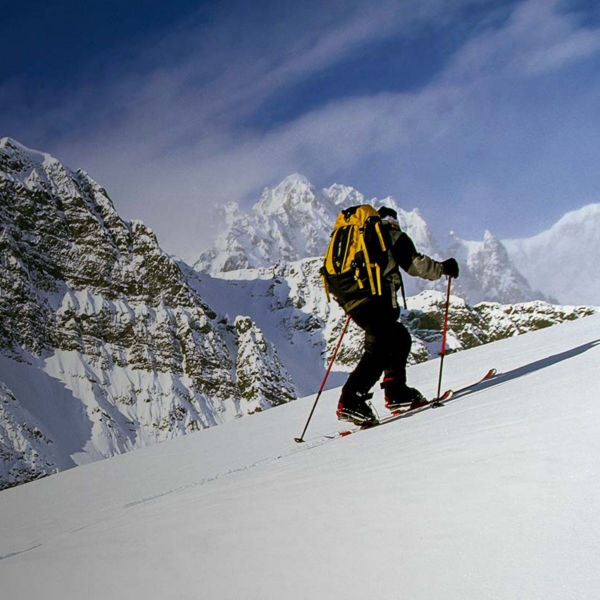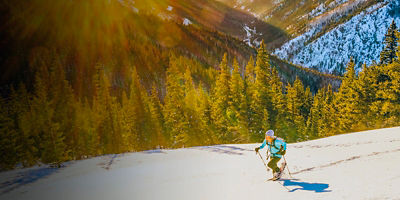
Alpine touring combines the best of downhill skiing (fun!) and the best of ski touring (cruising slowly through the snowy wilds). The most important piece of gear to achieve this winter win-win is your boots. Alpine touring (or AT) boots switch between two modes: a rigid, supportive “ski mode,” and a more flexible, comfortable “walk mode.” Finding the right balance between downhill performance and uphill comfort is the key to choosing the right boots. The most important elements to consider: your skill level, the type of terrain you ski, your ski bindings, and the shape of your foot.
Fit
Nothing affects your AT experience like boot fit. A well-fitting model will help you ski better, climb more comfortably, and stay warm. The trick? What makes a good fit might sound contradictory. You want boots that fit snugly for good downhill performance, but with enough room for all-day comfort, but not so much space that your foot slides around, especially in walk mode (a recipe for blisters). As a general guideline, fit should be a little more generous than with alpine boots. The fit of AT boots, like all shoes, varies by brand. You’ll want to try on several models, and understand how the two pieces of the boot work. These are:
Boot shell: This refers to the outer layer of plastic. Each brand uses its own foot mold to make shells, which is why you’ll see variations in volume and width and length. Specialist boot fitters can actually adjust the fit of a plastic shell, like making the toe box slightly wider (called “punching it out”).
Boot liner: The liner is the soft layer that goes inside the boot shell and that comes in contact with your feet and calves. Most quality boots come with “thermo-moldable” liners, which means they’ll conform to your feet when heated. This can result in a great fit and goes a long way toward enhancing comfort. Also, you can take liners out to dry between ski days.
What kind of skiing will you do?
At the most basic level, an AT boot offers a compromise between uphill and downhill performance. As with any compromise, that means tradeoffs: Some models tend to do better at one end of the spectrum or the other. Ask yourself what kind of skiing you’ll do most, then consider these three types of AT boots.
Touring boots: If you’ll spend long days exploring the backcountry, these are for you. Touring boots are lightweight (900 to 1,400 grams), with up to 75 degrees of cuff mobility, which prioritizes comfort in walk mode. They’re best for long missions when you’ll be spending hours in your boots, multi-day ski tours, and ski mountaineering objectives.
- Pros: very comfortable when skinning; lightweight; great for ski races; great for long days of touring
- Cons: OK downhill performance; not stiff enough for aggressive or heavy skiers on big boards; not great for resorts
All-mountain boots: As the name implies, these boots work well in a variety of backcountry conditions. They tend to weigh 1400 to 1600 grams, and have 40+ degrees of cuff movement. Generally, they strike a balance between weight and stiffness, and are meant to be used for both traditional ski touring and ski mountaineering. As such, they’re neither the most aggressive nor the lightest boots—a Goldilocks approach.
- Pros: good downhill control; comfortable when moving uphill; can handle the resort and the backcountry; a jack-of-all-trades
- Cons: master-of-none
Freeride Touring Boots: These boots prioritize downhill skiing over uphill comfort. They’re often as rigid as alpine ski boots, but still have the ability to switch between ski and walk mode, and usually have a rubber sole that helps when hiking. Aggressive skiers should gravitate towards these boots, as should those skiing equal amounts at resorts and in the backcountry. Look for weights above 1,500 grams, and cuff movement of up to 50 degrees.
- Pros: excellent downhill control; can double as resort and backcountry boots
- Cons: not as comfortable on long tours
Women’s boots
Most brands make boots specifically for women. Generally, they’ll share many of the same components and features as an equivalent men’s boot, but they typically have a softer flex, slightly different fit, and adhere to female sizing. Remember: Good fit is the only thing that matters, and all feet are different. There’s nothing wrong with a woman using a man’s boot, or vice versa. Some aggressive female skiers may opt for men’s boots, and conversely some smaller men might prefer the smaller sizes and flex ranges that come with women’s boots.






















